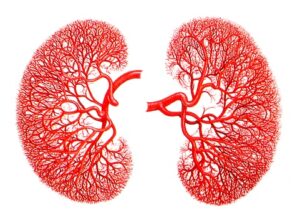According to the U.S. CDC, about 37 million adults in the United States have chronic kidney disease (CKD). As CKD progresses, many patients require dialysis and develop anemia, which is usually treated with blood transfusions, erythropoiesis-stimulating agents (ESAs), and intravenous iron. Previous clinical trials have linked ESA use, however, to increased risk of stroke, myocardial infarction, thrombosis, and even death when targeting a normal hemoglobin level (i.e., 13.0 to 14.0 g/dL). Daprodustat is a hypoxia-inducible factor (HIF) prolyl hydroxylase inhibitor (PHI) that stabilizes HIF and increases the expression of endogenous erythropoietin and ultimately production of red cells. In a randomized, open-label, phase 3 clinical trial, 2964 adult patients with CKD undergoing dialysis with a hemoglobin level between 8.0 to 11.5 g/dL were randomized 1:1 to receive daprodustat or ESA. Patients were followed for 2.5 years for changes in hemoglobin and major adverse cardiovascular events (including death). As reported in The New England Journal of Medicine, the mean baseline hemoglobin level was 10.4 g/dL. The mean hemoglobin increase during weeks 28 through 52 was 0.28 g/dL in the daprodustat arm and 0.10 g/dL in the ESA arm (difference = 0.18 g/dL [95% C.I., 0.12 to 0.24]). Major cardiovascular events occurred in 25.2% of patients in the daprodustat arm, similar to 26.7% in the ESA arm. The exact same percent of participants (3.6%) required blood transfusions in both arms. Data suggest that daprodustat was noninferior to ESAs; further studies are needed on the long-term effects and safety of daprodustat.
References:

